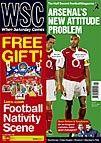 The Vikings are leading the way in Europe: a new competition for the top teams in Denmark, Norway and Sweden is attracting plenty of interest, including from Margot Dunne
The Vikings are leading the way in Europe: a new competition for the top teams in Denmark, Norway and Sweden is attracting plenty of interest, including from Margot Dunne
There is, as anyone who has ever witnessed the voting at the Eurovision Song Contest can tell you, a bond between Scandinavian countries born of more than a shared love of herrings, saunas and flat-pack furniture. It was perhaps inevitable that Norway, Sweden and Denmark would sooner or later link their football together in some way as there have been mutterings about it for many years. Thus the formation of the Royal League (so named because the three nations are all monarchies) comes as no surprise. They are, after all, broadly similar countries whose football clubs face roughly the same problems.
It has long been felt here that the relatively poor performance of Scandinavian teams in European competitions is due, in part at least, to lack of effective match practice for top clubs during the long closed season – November to March (slightly shorter in Denmark). Scandinavian football is winding up just as the UEFA Cup and Champions League are getting into full swing.
The Royal League is an attempt to address this problem, according to the managing director, Claus Rode Jensen, one of the driving forces behind the establishment of the new competition. The structure is simple. The top four clubs from each country play in three seeded groups; the winner and runner-up from each group go onto the next stage – two groups of three teams. The winners of those groups contest the final.
As far as the clubs involved are concerned, there is €125,000 (£88,000) for participating plus the cash from the television rights. The winners pick up another €1 million – no paltry sum for Scandinavian clubs. Former Denmark star Michael Laudrup, now manager of Brondby, believes his side will benefit from the extra competition the league will provide. “I think it is better to play games than to train,” he says. “The players prefer to play games and to play in competition, not training games. I’m very positive.”
UEFA have given the project their full approval because it takes place within existing football structures, running in addition to, rather than replacing, domestic league and cup competitions. Issues of fixture overcrowding don’t arise, according to Rode Jensen, because the Scandinavians, for reasons of climate and tradition, play a shorter season than is the case in many other countries so there is room on the calendar for more matches.
And, he says, other football associations are paying close attention to the progress of the Royal League. He has had interest from, among others, Scotland, Switzerland, Austria, Belgium, Holland and Croatia. It’s not difficult to see the appeal of such a model to smaller countries. Many have seen match attendances decline as the exodus of their star players and TV coverage
of the bigger foreign leagues have grown.
Regional leagues such as this could be the answer for a number of clubs who dominate their own domestic leagues but struggle to qualify for the group stages of the Champions League or UEFA Cup – Skonto Riga, for example, who have won every league title since Latvia’s independence 14 years ago but who have rarely progressed past the first game in European competition. Facing more effective opposition on a regular basis would no doubt be helpful.
UEFA deny that they are considering the formation of any other such leagues at the moment but, according to Rode Jensen, they are monitoring the Royal League closely and regard it very much as a pilot project. If this is so, then they must surely be encouraged by what they have seen so far: exciting, fiercely competitive opening games, eager teams, enthusiastic crowds and a good deal of largely positive media coverage – TV rights have even been sold in China.
What remains to be seen, though, is how the attendances and the pitches hold out when the ferocious winter weather really takes hold. There is, after all, a good reason why the Scandinavians traditionally play their football in the summer months. At Tromsø, 500km inside the Arctic Circle, they will play their home fixtures only thanks to undersoil heating and an army of 200 volunteers who will shovel the snow from the terraces. Perhaps, over the coming months, fans will have to heed the advice of one robust Tromsø supporter, swaddled in layers of Gore-Tex and festive reindeer patterned knitwear. “There is no such thing as bad weather,” she beamed. “Just bad clothing."
From WSC 215 January 2005. What was happening this month